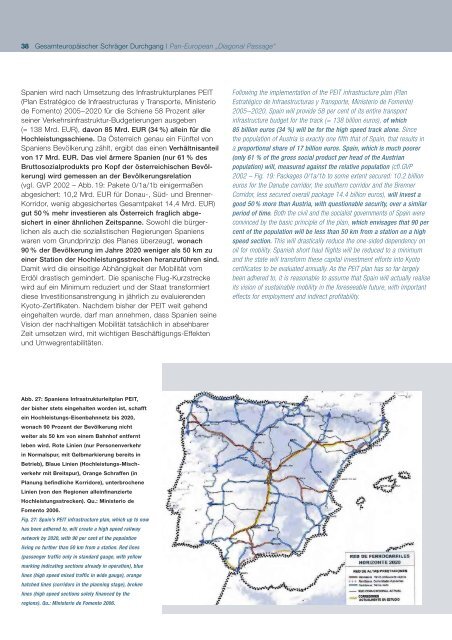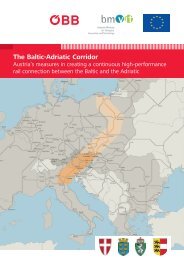Inhalt | Contens - baltic-adriatic.eu
Inhalt | Contens - baltic-adriatic.eu
Inhalt | Contens - baltic-adriatic.eu
Erfolgreiche ePaper selbst erstellen
Machen Sie aus Ihren PDF Publikationen ein blätterbares Flipbook mit unserer einzigartigen Google optimierten e-Paper Software.
38 Gesamt<strong>eu</strong>ropäischer Schräger Durchgang | Pan-European „Diagonal Passage“<br />
Spanien wird nach Umsetzung des Infrastrukturplanes PEIT<br />
(Plan Estratégico de Infraestructuras y Transporte, Ministerio<br />
de Fomento) 2005–2020 für die Schiene 58 Prozent aller<br />
seiner Verkehrsinfrastruktur-Budgetierungen ausgeben<br />
(= 138 Mrd. EUR), davon 85 Mrd. EUR (34 %) allein für die<br />
Hochleistungsschiene. Da Österreich genau ein Fünftel von<br />
Spaniens Bevölkerung zählt, ergibt das einen Verhältnisanteil<br />
von 17 Mrd. EUR. Das viel ärmere Spanien (nur 61 % des<br />
Bruttosozialprodukts pro Kopf der österreichischen Bevölkerung)<br />
wird gemessen an der Bevölkerungsrelation<br />
(vgl. GVP 2002 – Abb. 19: Pakete 0/1a/1b einigermaßen<br />
abgesichert: 10,2 Mrd. EUR für Donau-, Süd- und Brenner-<br />
Korridor, wenig abgesichertes Gesamtpaket 14,4 Mrd. EUR)<br />
gut 50 % mehr investieren als Österreich fraglich abgesichert<br />
in einer ähnlichen Zeitspanne. Sowohl die bürgerlichen<br />
als auch die sozialistischen Regierungen Spaniens<br />
waren vom Grundprinzip des Planes überz<strong>eu</strong>gt, wonach<br />
90 % der Bevölkerung im Jahre 2020 weniger als 50 km zu<br />
einer Station der Hochleistungsstrecken heranzuführen sind.<br />
Damit wird die einseitige Abhängigkeit der Mobilität vom<br />
Erdöl drastisch gemindert. Die spanische Flug-Kurzstrecke<br />
wird auf ein Minimum reduziert und der Staat transformiert<br />
diese Investitionsanstrengung in jährlich zu evaluierenden<br />
Kyoto-Zertifikaten. Nachdem bisher der PEIT weit gehend<br />
eingehalten wurde, darf man annehmen, dass Spanien seine<br />
Vision der nachhaltigen Mobilität tatsächlich in absehbarer<br />
Zeit umsetzen wird, mit wichtigen Beschäftigungs-Effekten<br />
und Umwegrentabilitäten.<br />
Abb. 27: Spaniens Infrastrukturleitplan PEIT,<br />
der bisher stets eingehalten worden ist, schafft<br />
ein Hochleistungs-Eisenbahnnetz bis 2020,<br />
wonach 90 Prozent der Bevölkerung nicht<br />
weiter als 50 km von einem Bahnhof entfernt<br />
leben wird. Rote Linien (nur Personenverkehr<br />
in Normalspur, mit Gelbmarkierung bereits in<br />
Betrieb), Blaue Linien (Hochleistungs-Misch-<br />
verkehr mit Breitspur), Orange Schraffen (in<br />
Planung befindliche Korridore), unterbrochene<br />
Linien (von den Regionen alleinfinanzierte<br />
Hochleistungsstrecken). Qu.: Ministerio de<br />
Fomento 2006.<br />
Fig. 27: Spain’s PEIT infrastructure plan, which up to now<br />
has been adhered to, will create a high speed railway<br />
network by 2020, with 90 per cent of the population<br />
living no further than 50 km from a station. Red lines<br />
(passenger traffic only in standard gauge, with yellow<br />
marking indicating sections already in operation), blue<br />
lines (high speed mixed traffic in wide gauge), orange<br />
hatched lines (corridors in the planning stage), broken<br />
lines (high speed sections solely financed by the<br />
regions). Qu.: Ministerio de Fomento 2006.<br />
Following the implementation of the PEIT infrastructure plan (Plan<br />
Estratégico de Infraestructuras y Transporte, Ministerio de Fomento)<br />
2005–2020, Spain will provide 58 per cent of its entire transport<br />
infrastructure budget for the track (= 138 billion <strong>eu</strong>ros), of which<br />
85 billion <strong>eu</strong>ros (34 %) will be for the high speed track alone. Since<br />
the population of Austria is exactly one fifth that of Spain, that results in<br />
a proportional share of 17 billion <strong>eu</strong>ros. Spain, which is much poorer<br />
(only 61 % of the gross social product per head of the Austrian<br />
population) will, measured against the relative population (cfl.GVP<br />
2002 – Fig. 19: Packages 0/1a/1b to some extent secured: 10.2 billion<br />
<strong>eu</strong>ros for the Danube corridor, the southern corridor and the Brenner<br />
Corridor, less secured overall package 14.4 billion <strong>eu</strong>ros), will invest a<br />
good 50 % more than Austria, with questionable security, over a similar<br />
period of time. Both the civil and the socialist governments of Spain were<br />
convinced by the basic principle of the plan, which envisages that 90 per<br />
cent of the population will be less than 50 km from a station on a high<br />
speed section. This will drastically reduce the one-sided dependency on<br />
oil for mobility. Spanish short haul flights will be reduced to a minimum<br />
and the state will transform these capital investment efforts into Kyoto<br />
certificates to be evaluated annually. As the PEIT plan has so far largely<br />
been adhered to, it is reasonable to assume that Spain will actually realise<br />
its vision of sustainable mobility in the foreseeable future, with important<br />
effects for employment and indirect profitability.



